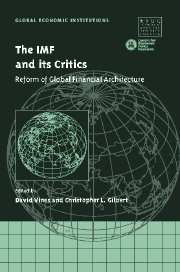Book contents
- Frontmatter
- Contents
- List of figures
- List of tables
- List of contributors
- Acknowledgements
- Introduction
- 1 The IMF and international financial architecture: solvency and liquidity
- 2 Progress towards greater international financial stability
- 3 International coordination of macroeconomic policies: still alive in the new millennium?
- 4 The Report of the International Financial Institution Advisory Commission: comments on the critics
- 5 Reforming the global financial architecture: just tinkering around the edges?
- 6 The IMF and capital account liberalisation
- 7 How should the IMF view capital controls?
- 8 The resolution of international financial crises: an alternative framework
- 9 Whose programme is it? Policy ownership and conditional lending
- 10 The IMF and East Asia: a changing regional financial architecture
- 11 The role of the IMF in developing countries
- 12 Argentina and the Fund: anatomy of a policy failure
- 13 Countries in payments' difficulties: what can the IMF do?
- 14 Accountability, governance and the reform of the IMF
- 15 The IMF at the start of the twenty-first century: what has been learned? On which values can we establish a humanised globalisation?
- Index
12 - Argentina and the Fund: anatomy of a policy failure
Published online by Cambridge University Press: 04 December 2009
- Frontmatter
- Contents
- List of figures
- List of tables
- List of contributors
- Acknowledgements
- Introduction
- 1 The IMF and international financial architecture: solvency and liquidity
- 2 Progress towards greater international financial stability
- 3 International coordination of macroeconomic policies: still alive in the new millennium?
- 4 The Report of the International Financial Institution Advisory Commission: comments on the critics
- 5 Reforming the global financial architecture: just tinkering around the edges?
- 6 The IMF and capital account liberalisation
- 7 How should the IMF view capital controls?
- 8 The resolution of international financial crises: an alternative framework
- 9 Whose programme is it? Policy ownership and conditional lending
- 10 The IMF and East Asia: a changing regional financial architecture
- 11 The role of the IMF in developing countries
- 12 Argentina and the Fund: anatomy of a policy failure
- 13 Countries in payments' difficulties: what can the IMF do?
- 14 Accountability, governance and the reform of the IMF
- 15 The IMF at the start of the twenty-first century: what has been learned? On which values can we establish a humanised globalisation?
- Index
Summary
Introduction
In the sad economic history of Argentina since the 1950s, the 1990s encompassed a remarkable transition. Rising from the ashes of yet another episode of economic chaos and hyper-inflation at the end of the 1980s, the surprisingly orthodox policies of the new Perónist President, Carlos Menem, brought a decisive end to decades of monetary instability and launched the Argentine economy into four years of unusually rapid expansion. Those economic policies featured a hard peg of the Argentine peso at parity to the US dollar, backed by the Convertibility Plan, which strictly limited domestic money creation under a currency board-like arrangement. Many doubted whether the new policy regime would survive, especially as tensions rose during the ‘tequila crisis’ initiated by the Mexican devaluation of December 1994. But it did survive; and after a sharp recession in 1995, the Argentine economy resumed rapid growth from late 1995 until the spillover effects of the Brazilian crisis hit Argentina in late 1998. Indeed, with most of the economies of emerging Asia collapsing into crises from mid-1997 to early 1998, Argentina became the darling of emerging-market finance – able to float large issues of medium- and longer-maturity debt on world credit markets at comparatively modest spreads over US Treasuries. And, in the official international financial community, especially the International Monetary Fund (IMF), many of Argentina's economic policies were widely applaudedand suggested as a model that other emerging-market countries should emulate – international approval that was dramatised by President Menem's triumphant address to the IMF/World Bank Annual Meeting on 4 October 1998.
- Type
- Chapter
- Information
- The IMF and its CriticsReform of Global Financial Architecture, pp. 316 - 362Publisher: Cambridge University PressPrint publication year: 2004
- 1
- Cited by



